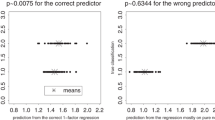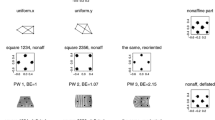Abstract
A general morphometric procedure is described that organizes collections of microfossil outlines according to their shape. It involves representing the greatest proportion of variation observed among a collection of shapes by the least number of different shapes. Since these are determined as empirical orthogonal shape functions—eigenfunctions—of the observed shapes, the procedure is termed eigenshape analysis. Observed shapes are arranged and their shape differences systemized by reference to these determined eigenshape functions. The well-known ecophenotypic shape variation with latitude exhibited by the Pleistocene planktonic foraminifer Globorotalia truncatulinoides (d'Orbigny)serves as an example.
Similar content being viewed by others
References
Anstey, R. L. and Delmet, D. A., 1972, Genetic meaning of zooecial chamber shapes in fossil bryozoans: Fourier analysis: Science, v. 177, p. 1000–1002.
Anstey, R. L. and Pachut, J. F., 1980, Fourier packing ordinate: a univariate size-independent measurement of polygonal packing variation in Paleozoic bryozoans: Jour. Math. Geol., v. 12, p. 139–156.
Aubrey, D. G., Inman, D. L., and Winant, C. D., 1980, The statistical prediction of beach changes in Southern California: Jour. Geophys. Res., v. 85, p. 3264–3276.
Benson, R. H., 1967, Muscle scar patterns of Pleistocene (Kansan) ostracodes,in Curt Teichert and E. L. Yochelson, (Eds.), Essays in paleontology and stratigraphy: Kansas University Press, Lawrence, Kansas, p. 211–241.
Blackith, R. E. and Reyment, R. A., 1971, Multivariate morphometrics: Academic Press, London, 412 p.
Bookstein, F. L., 1978, The measurement of biological shape and shape change: Springer-Verlag, Berlin, 191 p.
Bookstein, F. L., Strauss, R. E., Humphries, J. M., Chernoff, B. C., Elder, R. L., and Smith, G. R., 1982, A comment upon the uses of Fourier methods in systematics: Systematic Zool., v. 31, p. 85–92.
Canfield, D. J. and Anstey, R. L., 1981, Harmonic analysis of cephalopod suture patterns: Jour. Math. Geol., v. 13, p. 23–35.
Christopher, R. A. and Waters, J. A., 1974, Fourier analysis as a quantitative descriptor of miosphere shape: Jour. Paleo., v. 48, p. 697–709.
Cooley, W. S. and Lohnes, P. R., 1971, Multivariate data analysis: Wiley & Sons, New York, 364 p.
Davis, R. E., 1976, Predictability of sea surface temperature and sea level pressure anomalies over the North Pacific Ocean: Jour. Phys. Oceanog., v. 6, p. 249–266.
Delmet, D. A. and Anstey, R. L., 1974, Fourier analysis of morphological plasticity within an Ordovician bryozoan colony: Jour. Paleo., v. 48, p. 217–226.
Ehrlich, R. and Weinberg, B., 1970, An exact method for characterization of grain shape: Jour. Sed. Pet., v. 40, p. 205–212.
Ehrlich, R., Orzeck, J., and Weinberg, B., 1974, Detrital quartz as a natural tracer—Fourier grain shape analysis: Jour. Sed. Pet., v. 44, p. 145–150.
Fico, C., 1980, Development of ARTHUR II—a fast microprocessor controlled particle shape analyzer: M.S. thesis, University of South Carolina, Columbia, S.C. (unpublished).
Gevirtz, J. L., 1976, Fourier analysis of bivalve outlines: implications on evolution and autecology: Jour. Math. Geol., v. 8, p. 151–163.
Golub, G. H. and Reinsch, C., 1970, Singular value decomposition and least squares solutions: Numer. Math., v. 14, p. 403–420.
Healy-Williams, N. and Williams, D. F., 1981, Fourier analysis of test shape of planktonic foraminifera: Nature, v. 289, p. 485–487.
Kaesler, R. L. and Waters, J. A., 1972, Fourier analysis of the ostracode margin: Geol. Soc. Amer. Bull., v. 83, p. 1169–1178.
Kennett, J. P., 1968,Globorotalia truncatulinoides as a paleo-oceanographic index: Science, v. 159, p. 1461–1463.
Lohmann, G. P. and Carlson, J. J., 1981, Oceanographic significance of Pacific Late Miocene calcareous nannoplankton: Marine Micropaleo., v. 6, p. 553–579.
Lohmann, G. P. and Denham, C. R., in press, Eigenshape analysis programs: Comput. Woods Hole Oceanog. Inst., Tech. Rep.
Lohmann, G. P. and Malmgren, B. A., in press, Equatorward migration ofGloborotalia truncatulinoides through the Late Pleistocene. Submitted to Paleobio.
Lorenz, E. N., 1959, Empirical orthogonal functions and statistical weather prediction: Rept. No. 1, Statistical Forcasting Project, Dept. of Meteorology, M.I.T.
Malmgren, B. and Kennett, J. P., 1981, Phyletic gradualism in a Late Cenozoic planktonic foraminiferal lineage; DSDP Site 284, southwest Pacific. Paleobiology, v. 7, p. 230–240.
Pielou, E. C., 1969, An introduction to mathematical ecology, John Wiley & Sons, New York, 286 p.
Prezbindowski, D. R. and Anstey, R. L., 1978, A Fourier-numerical study of a bryozoan fauna from the Threeforks Formation (Late Devonian) of Montana: Jour. Paleo., v. 52, p. 353–369.
Schwarcz, H. P. and Shane, K. C., 1969, Measurement of particle shape by Fourier analysis: Sedimentology, v. 13, p. 213–231.
Scott, G. H., 1975, Variation inGloborotalia miozea (Foraminiferida) from the New Zealand Neogene: N. Z. Jour. Geol. Geophys., v. 18, p. 865–880.
Scott, G. H., 1980, The value of outline processing in the biometry and systematics of fossils: Paleontology, v. 23, p. 757–768.
Scott, G. H., 1981, Upper Miocene biostratigraphy: DoesGloborotalia conomiozea occur in the Messinian? Rev. Espanola Micropaleo, v. 12, p. 489–506.
Waters, J. A., 1977, Quantification of shape by use of Fourier analysis: the Mississippian blastoid genusPentremites: Paleobiology, v. 3, p. 288–299.
Winant, C. D., Inman, D. L., and Nordstrom, C. E., 1975, Description of seasonal beach changes using empirical eigenfunctions: Jour. Geophys. Res., v. 80, p. 1979–1986.
Younker, J. L. and Ehrlich, R., 1977, Fourier biometrics: harmonic amplitudes as multivariate shape descriptors: System Zool., v. 26, p. 336–342.
Zahn, C. T. and Roskies, R. Z., 1972, Fourier descriptors for plane closed curves: IEEE Trans. Comput., v. C-21, p. 269–281.
Author information
Authors and Affiliations
Rights and permissions
About this article
Cite this article
Lohmann, G.P. Eigenshape analysis of microfossils: A general morphometric procedure for describing changes in shape. Mathematical Geology 15, 659–672 (1983). https://doi.org/10.1007/BF01033230
Received:
Revised:
Issue Date:
DOI: https://doi.org/10.1007/BF01033230




